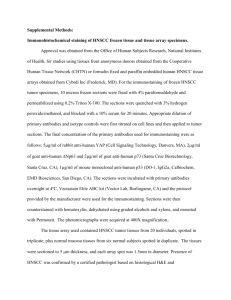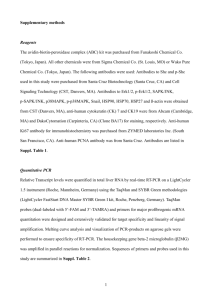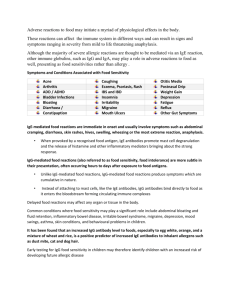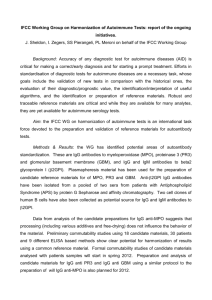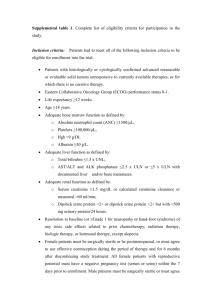hep_22680_sm_SupMat
advertisement
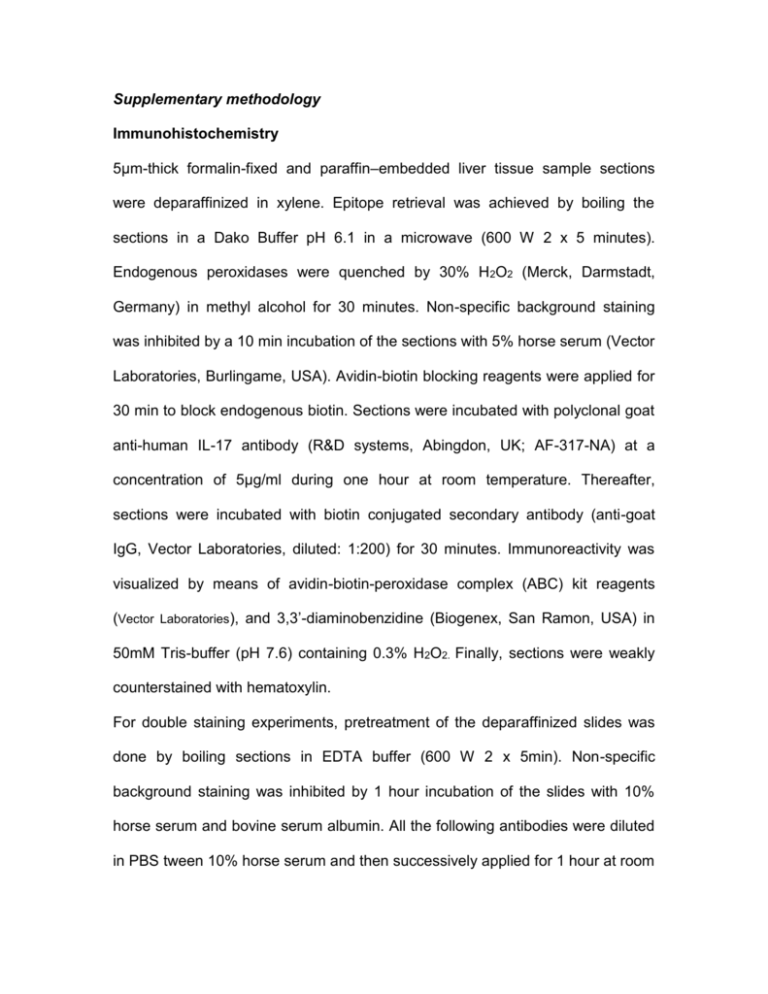
Supplementary methodology Immunohistochemistry 5µm-thick formalin-fixed and paraffin–embedded liver tissue sample sections were deparaffinized in xylene. Epitope retrieval was achieved by boiling the sections in a Dako Buffer pH 6.1 in a microwave (600 W 2 x 5 minutes). Endogenous peroxidases were quenched by 30% H2O2 (Merck, Darmstadt, Germany) in methyl alcohol for 30 minutes. Non-specific background staining was inhibited by a 10 min incubation of the sections with 5% horse serum (Vector Laboratories, Burlingame, USA). Avidin-biotin blocking reagents were applied for 30 min to block endogenous biotin. Sections were incubated with polyclonal goat anti-human IL-17 antibody (R&D systems, Abingdon, UK; AF-317-NA) at a concentration of 5µg/ml during one hour at room temperature. Thereafter, sections were incubated with biotin conjugated secondary antibody (anti-goat IgG, Vector Laboratories, diluted: 1:200) for 30 minutes. Immunoreactivity was visualized by means of avidin-biotin-peroxidase complex (ABC) kit reagents (Vector Laboratories), and 3,3’-diaminobenzidine (Biogenex, San Ramon, USA) in 50mM Tris-buffer (pH 7.6) containing 0.3% H2O2. Finally, sections were weakly counterstained with hematoxylin. For double staining experiments, pretreatment of the deparaffinized slides was done by boiling sections in EDTA buffer (600 W 2 x 5min). Non-specific background staining was inhibited by 1 hour incubation of the slides with 10% horse serum and bovine serum albumin. All the following antibodies were diluted in PBS tween 10% horse serum and then successively applied for 1 hour at room temperature. Firstly, the anti-human IL-17 (5µg/ml) or mouse anti-human αsmooth muscle actin (Novocastra, Newcastle, UK; clone asm-1, 1/1000) antibodies were applied. Secondly, Tetramethylrhodamine isothiocyanate (TRITC) conjugated anti-goat IgG (Sigma Aldrich, Bornem, Belgium, T6028, 1/600) or fluorescein isothiocyanate (FITC) conjugated anti-mouse IgG (Invitrogen, Merelbeke, Belgium F2761, 1/1000) antibodies were applied in darkness. Thirdly mouse anti-human CD3 (Novocastra, clone PS1; 1/100), rabbit anti-human myeloperoxidase (MPO, Novocastra, NCL-MYELOp, 1/200) or goat anti-human IL-17R (Santa Cruz, Ca; SC-23124, 1/160) antibodies were applied in the same conditions. Finally, FITC-labelled goat anti-mouse IgG, Alexa Fluor 488-labelled donkey anti-rabbit IgG (Invitrogen, A21206, 1/400) or TRITCconjugated anti-goat IgG antibodies were applied in darkness. Nuclear counterstaining was performed by incubating slides with diaminidophenylindol (DAPI, Invitrogen, D1306, 1/100 in PBS) during 4 min. Normal mouse, goat or rabbit IgG was used as a negative control. Cell culture Human Hepatic Stellate Cells (HSC) were isolated, characterized and cultured as described previously (33,34,35). Cells were cultured on plastic dishes in Iscove’s modified Dulbecco’s medium (Cambrex) supplemented with 20% FBS, 0.1 mM non essential amino acids (Cambrex) and antibiotics-antimycotic solution (Sigma A5955 1/100) Experiments were performed on cells between serial passages 3 and 8, when HSC exhibited the morphologic features of the “myofibroblast-like” phenotype (34). Flow cytometry analysis Intracellular staining for IL-17 or IFN-γ production was detected after overnight culture, followed by 5 hours stimulation of PBMCs with 20ng/ml phorbol 12myristate 13-acetate (PMA, Sigma) and 1µg/ml calcium ionophore III (A23187, Sigma), in the presence of 3µg/ml Brefeldin A (e-bioscience, San Diego, CA) and Cytofix / Cytoperm Fixation / Permeabilization kit (BD bioscience, San Jose, CA) according to manufacturer’s instructions. Intracellular labelling for IL-17 (ebioscience, clone eBio064CAP17), IFN-γ (BD clone 25723.11), or IgG1κ isotype control (e-bioscience, clone P3) were performed using Phycoerythrin-conjugated mouse anti-human antibodies. Surface staining with fluorescein isothiocyanatelabelled anti-CD3 and allophycocyanin-labelled anti-CD4 (BD, clone SK7 and RPA-T4 respectively) mouse anti-human antibodies were done before labelling of intracellular antigens. Cell analysis by flow cytometry was performed using a FACScalibur (BD Bioscience). At least 30.000 events were acquired on gated lymphocytes. Because non specific IgG1κ isotype induced a shift of the whole group of plots, positive staining cut-off was determined in comparison to the non Phycoerythrin-labelled tube. FACS analysis was done using Cell Quest Pro software 4.0 (BD Bioscience). Membrane IL-17R labelling of HSC was performed by incubating cells with allophycocyanin-labelled monoclonal anti-human IL-17R or control isotype following manufacturer’s instructions (R&D Systems) FAB177A and IC002A, respectively). RNA extraction and Reverse Transcriptase Polymerase Chain Reaction For classical RT-PCR, cells were lysed in Tripure Reagent (Roche Diagnostics, Basel, Switzerland) and total RNA was extracted using the High Pure RNA Tissue kit (Roche Diagnostics) following the manufacturer’s protocol. This procedure included DNase treatment. Reverse Transcription was performed as follows: 1µg of total RNA and 0.4 µg oligo-dT primers were incubated at 65°C for 5 min and then chilled on ice. Then other components were added to the mix, containing deoxynucleotides (dNTPs 1µM) mix, porcine RNase inhibitor (25 U, Amersham Bioscience, Rosendaal, NL) and Transcriptor Reverse Transcriptase (1U, Roche Diagnostics) for a total volume of 20 µl by sample. The first-strand synthesis was then performed for 1h incubation at 42°C, followed by 15 min incubation at 70°C to inactivate reverse transcriptase enzyme. Each classical PCR reaction mixture contained 0.25µM dNTPs, 0.05U/ml Taq DNA polymerase (Roche Diagnosctics), 1.875 mM MgCl2, and 5ng/ml of each primer for a total volume of 20 µl per well, to which 5µl of cDNA was added. Thermal cyclers were performed as follows on a T3Thermocycler (Biometra, Goettingen, Germany): 94 °C for 4 min followed by 45 cycles alternating 94°C for 4 seconds, 58°C for 20 seconds and 72°C for 30 seconds. Thereafter, 5µl of cDNA product were loaded on an agarose Flash Gel (Lonza, Verviers, Belgium). Quantitative RT-PCR for αSMA and α1procollagen type 1 were performed as previously described (9) using a one-step RT-PCR reaction (Light Cycler, Roche Diagnostics) on mRNA extracted with the Magnapure technology (Roche Diagnostics). The primers for IL-17R, subunit A, αSMA and α1 procollagen type I and HPRT were designed using primer3 software (Whitehead Institute for Biomedical Research, Cambridge, MA): 5’-Forward-3’ primer 5’-reverse-3’ primer 5’-(6-Fam) Taqman Probe-3’ gene NCBI code IL-17RA NM_014339 CTCGAGGGTGCAGAGTTATCT GTAGAGTGAGTGTGACGTTGGA αSMA NM_001613 TGATCACCATCGGAAATGAAC TTCATGGATGCCAGCAGACT TCCGCTGCCCAGAGACCCTG α1procollagen type I HPRT NM_000088 GCAACATGGAGACTGGTGAGA GGGTTCTTGCTGATGTACCAGTTC TCAGCCCAGTGTGGCCCAGA NM_000194 AGTCTGGCTTATATCCAACACTTCG GACTTTGCTTTCCTTGGTCAGG TTTCACCAGCAAGCTTGCGACCTTGA Supplementary figure 6 (normalized to HPRT) SMA mRNA fold increase 5 * 4 3 2 1 0 IL-17 (ng/ml) TGFβ (ng/ml) 0 - 0.1 - 1 - 10 - 1 * 3 (normalized to HPRT) 1procollagen I mRNA fold increase 4 2 1 0 IL-17 (ng/ml) TGFβ (ng/ml) 0 - 0.1 - 1 - 10 - 1 12 (normalized to HPRT) IL-8 mRNA fold increase 10 8 * 6 4 2 0 IL-17 (ng/ml) 0 0.1 1 10 Supplementary fig.1 Supplementary figure legend Fig.1: IL-17 does not induce a direct fibrogenic effect on Hepatic stellate cells in vitro. Quantitative RT-PCR of α-smooth muscle actin, α1-procollagen 1 and interleukin8 on mRNA extracted from hepatic stellate cells stimulated with increasing doses of recombinant IL-17 or TGFβ as a positive control, for 24h culture. Errors bars represent means ± s.e.m of 3 to 9 independent experiments. *p<0.05 versus no stimulation.

